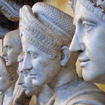Art and Music - Grammar
Pre-intermediate level
Description
Materials
Main Aims
-
To provide clarification of the past continuous tense in the context of Art
Subsidiary Aims
-
To provide accuracy speaking practice in a conversation in pairs in the context of art
Procedure (40-51 minutes)
T asks Ss to describe the last time they did something cultural. Modeling: When I lived in Paris, I went to museums all the time. My favorite museum is the Louvre. The last time I went was in December. It was a rainy day, so I wanted to stay inside. I saw the Mona Lisa, the venus de Milo, and I met a friend of mine. We chatted for a little bit, and then she left. I didn't buy any souvenirs, not even a postcard. Instructions: 4 minutes to talk about their experience in pairs. FB: What experience did your partner tell you about? T asks two or three students WC.
T tells Ss that we’re going to look again at the texts they learned about in previous lesson. Instructions: Complete the sentences orally with a partner, answering from memory. Try to recall any other information you learned earlier. T gives students handout with sentences. FB: Once majority of students have finished, Ss now check their answers with another group. T asks students to read their sentences. Check with class after each one - is this correct?
T draws regular/irregular columns on the board + list of verbs. A. Put them in the correct category – regular, irregular (individual, 30 sec) AFTER they do that, then: B. Put verbs into simple past (individual, check with partner, WC FB) T draws timeline on board. Explain when we use SP and PC. T refers to sentences on the board – what is the most important information in each sentence? Which sentences are NOT in the present simple? Why? T draws grammar box. Form: Subjet + to be (past=was/were) + verb + ing Ss help T fill in the box with the verb WORK. T divides students into half: group 1 on the left, group 2 on the right. Instructions: One student from each side comes to the board. T says (1) subject and (2) verb. Ss conjugate verb into (+), (-) and (?) in the Past Continuous (T writes categories on board.) The first to finish gets a point.
Instructions: Underline the correct answer, work individually, 2 minutes. FB: Ss check answers with partner. Go over answers as WC.
Ss do exercise individually. Once finished, Ss check with their partner to see if they have the correct answer. FB (WC) – one student reads each sentence, T asks why they selected which tense (ask about main information vs. background information).
T lists verbs on the board. What is the difference between the ED sounds in each of these verbs? T asks Ss to place verbs under the correct category based on its sound. How do you know where they go? T elicits the letters from them, and fill in the ones they don’t know. t, id, d sounds • We pronounce / t / after voiceless sounds: / p /, / k /, / s /, / f / and voiceless / th / sound Asked, finished, worked • We pronounce / d / after voiced sounds: / b / , / g /, / v /, / z/ , / m/ , /n /, / l /, / r / , voiced / th / sound and all vowels. Listened, discovered, loved • We pronounce / id / after / d / and / t / sounds. Hated, needed, started, wanted Drilling: Do each word separately, first in bigger groups, then individually. Once we’ve drilled all the words, T picks words and students at random to drill.
T evokes warm up activity. We’re going to talk again about our cultural experiences, but using the past continuous. T asks students to recall her example. T then models new example with PC tense, emphasizing actions being interrupted, and the use of when and while. Example: Last December, when I was in Paris, I went to the Louvre. While I was visiting the impressionist wing, I saw a friend of mine. We were chatting about Monet and Renoir when she told me she had to leave. Later, while I was buying a postcard, I realized that I had no money. So I bought nothing. Instructions: In pairs Ss do the same thing. 5 minutes. FB: In groups of 4, Ss check sentences for PC tense. After, do WC FB, put incorrect sentences on the board, sentences overheard while monitoring.

